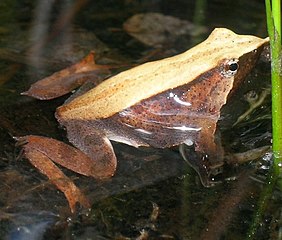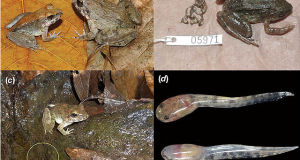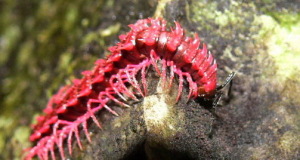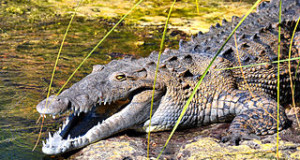When it comes to inventive – some might say bizarre – breeding habits, amphibians are without equal. Several, such as the skin-brooding Surinam Toad, are well-known, but recent studies have revealed others that could not have been predicted – i.e. tree-dwelling tadpoles that consume bark and others that gorge upon their father’s skin (which re-grows for their dining pleasure!) or on “egg omelets” whipped up by mom (please see articles linked below). But even Charles Darwin would be shocked by the habits of a small frog he first described on his famous voyage, the Darwin’s Frog, Rhinoderma darwini. Males guard their eggs and then gobble them up. The tadpoles live in the vocal sac, feed upon nutritious parental secretions, and then emerge from their fathers’ mouths as fully-formed froglets! Sadly, all evidence indicates that this astonishing creature is almost extinct – the latest victim of the infamous chytridiomycosis epidemic. A related species, the Chilean Darwin’s Frog (Rhinoderma rufum), utilizes a modified version of this bizarre strategy…this species appears to be extinct (please see below).
Stomach-Brooding Frogs have also Vanished
A deadly amphibian disease that assumed epidemic proportions approximately 20 years ago has been blamed for the likely extinction of the Darwin’s Frog, the only amphibian known to rear its tadpoles entirely within the male’s vocal sacs.
Two other recently-extinct species, Australia’s Gastric Brooding Frogs, Rheobatrachus silus and R. vitellinus, also exhibited surprising brooding methods. Both incubated their eggs in the stomach…and somehow stopped the release of digestive enzymes while doing so (this ability may have held important information for researchers studying human digestive diseases). Despite intensive searches, Rheobatrachus silus has not been seen since 1981; R. vitellinus vanished in 1985.
Any extinction is tragic, but the loss of creatures that have somehow evolved such mind-boggling survival strategies seems especially so..
Darwin’s Frog Natural History
Although less than 1.5 inches in length, Darwin’s Frog was quite impressive in appearance. An elongated, pointed snout lent the head a triangular shape, and added to the overall leaf-like appearance. The body was clad in pale to bright green, light to dark brown, or a variety of combinations of these colors.
When camouflage failed it, the tiny creature feigned death…often by jumping into a stream and floating away on its back!
Range and Habitat
Darwin’s Frog ranged from central and southern Chile into Argentina, where it lived along streams within temperate forests and in wooded bogs. Active by day, it was out and about even at temperatures of 40-45 F, and frequently basked in the sun.
“Male Nursing”?!
Studies revealed that the Darwin’s Frog’s breeding biology was even more unusual than first believed. Males call by day and night throughout the November to March rainy season. Amplexus and egg-deposition occurs on land.
Thereafter, males guard their 20-40 large eggs for approximately 20 days. Once the tadpoles begin moving within the eggs, they are taken into the male’s mouth and maneuvered through openings that lead into the vocal sac. Perhaps as an adaptation to its most unusual secondary role, the vocal sac is huge, stretching over the frog’s abdomen to the groin area.
But the surprises do not stop here! Amazingly, male Darwin’s Frogs release nutrient laden secretions that serve as food for their tadpoles. These nutrients are first absorbed through the skin, but as the tadpoles mature they feed by mouth…perhaps the only “normal” habit they possessed! Once metamorphosis was complete, the odd little frogs exited their dad’s mouths and took up life on their own.
The Chilean Darwin’s Frog (Rhinoderma rufum) also broods in the vocal sac, but the tadpoles are released into water when partially grown. Confined to a tiny section of central Chile, it has not been seen since 2006. There are no other related species.
Other Unusual Frogs
Thankfully, many frogs that exhibit astonishing breeding behaviors still exist, and new ones are discovered regularly. For example, Red-Eyed Treefrog eggs hatch early if attacked by wasps, and male African Bullfrogs construct channels to bring water to dehydrating tadpoles. Others are mentioned in this article’s opening paragraph. Please see the articles linked below to read more about each and, if you have the means, get out there and find some Darwin’s Frogs (“re-discoveries have happened!).
 That Reptile Blog – Reptile, Amphibian and Exotic Pet Care and Information
That Reptile Blog – Reptile, Amphibian and Exotic Pet Care and Information







Frank, can you please tell me the predators of Darwin’s frogs, besides the chucao bird?
Thank you.
Hello Janet,
I do not have very much info on it’s predators…there have been some field studies published in several journals as I recall, but these are generally only available via subscription. Try searching online under the species name and the journals Copeia, Journal of Herpetology and Herpetological Review…your library should be able to obtain relevant issues if online search is not useful. Best regards, frank